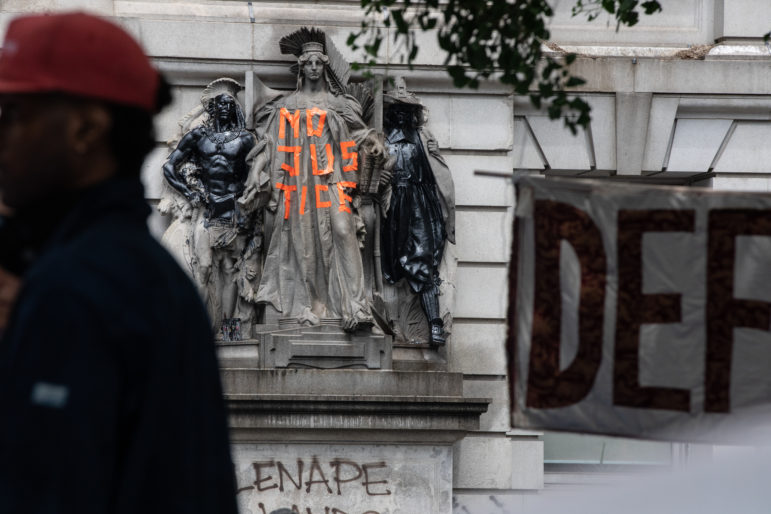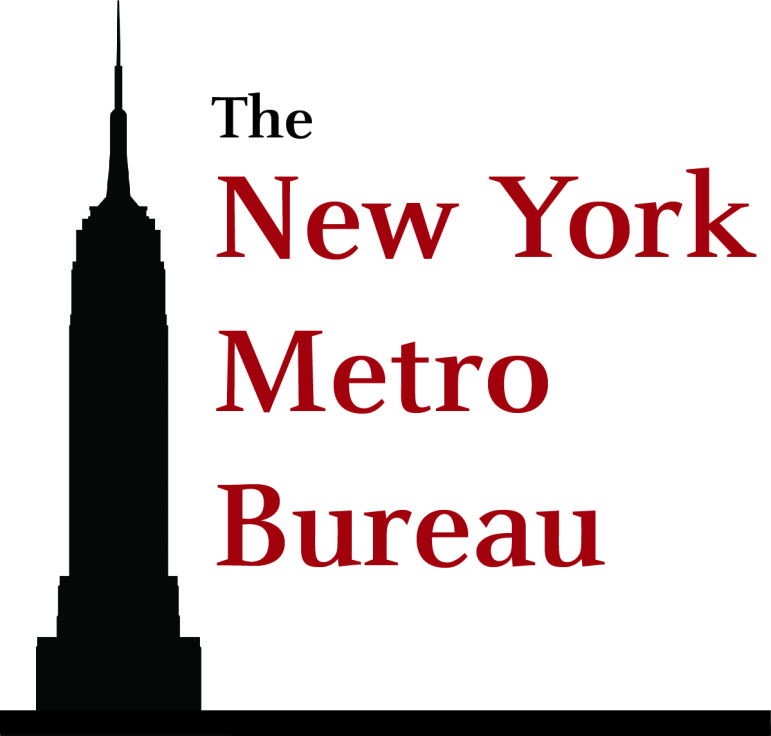
Marco Poggio
Graffiti from protesters on Surrogate’s Court in Lower Manhattan.
NEW YORK — The Surrogate’s Court in Lower Manhattan received a fresh coat of paint — albeit an unprompted one, after graffiti, as colorful in its language as it was in its incandescence, was scrawled across the building by anti-police protesters.
Nearby, an elevator shaft for the City Hall 4/5/6 train was covered in scraps of cardboard etched with messages memorializing the lives of Black Americans killed by police.
Demonstrators had encamped in the area around City Hall for days while inside city officials dealt with one of the most significant political issues of their time — how to effect massive reforms to the nation’s largest police department without sacrificing public safety.
The solution from city leaders, much to the consternation of some protesters who envisioned a wholesale removal of police altogether, has been to enact a massive shift in funding away from the New York Police Department (NYPD), to the tune of nearly $1 billion, and reinvest it into communities of color.
After midnight this morning the City Council voted on a budget that includes deep cuts to NYPD personnel and shifts millions to other city agencies.
The billion dollars in cuts had become a point of contention among council members, with some like Jimmy Van Bramer voting against the budget until it included the full cuts.
In a statement before the vote, Van Bramer explained that ongoing protests, as well as deep cuts to arts and culture funding, prompted his dissent.
“The people have demanded a real, $1 billion cut to the NYPD, but also a reimagining of public safety in this City,” the statement read, adding that “The people have spoken through marches and rallies and by occupying City Hall. We must listen to the people we work for. That is our job.”
The cuts were coming anyway. After a monthslong shutdown of the city economy from the coronavirus pandemic triggered a massive $9 billion deficit, the city had no choice but to slash department budgets across the city.
At the same time as the pandemic, outrage following the death of George Floyd on May 25 in Minneapolis reignited a national conversation over policing, particularly the size of police budgets and the scope of their operations.
That outrage has deeply permeated into New York, as city officials now reverse course on budget cuts, many of which would have impacted young people of color.
Summer jobs for youth rescued
Before national protests, programs like Summer Youth Employment, a city-led program that offers jobs to low-income youth, was almost certainly destined to be drained under the new budget.
But on Tuesday, Mayor Bill de Blasio announced that some of the funding from the NYPD cuts will be shifted to save the program, with $134 million now expected to create over 100,000 new jobs for young people across the city.
Part of a broader package that needed to be passed by Tuesday, the budget agreement between de Blasio and City Council included a striking decision to end a 21-year agreement between the NYPD and city schools.
The agreement, which gave the NYPD control of all school safety operations, came under criticism recently by both activists and elected officials who charge that having uniformed officers in schools sent the wrong message to students.
The battle over the post-pandemic budget has been fraught, with activists outside accusing city leaders, particularly individual City Council members, of not being transparent enough in the process.
One vocal Twitter user whose real name is Aaron Fernando, 19, came under immense criticism from council members after he posted their personal cellphone numbers online.
In a statement, Fernando defended the act by suggesting that members were not answering their phones, or engaging their constituents in conversation about the budget.
“It’s important that politicians are held accountable for their actions, and New Yorkers deserve a representative body that is responsive to the demands of their communities,” the statement read. “It’s unfortunate that rather than listening to their constituents, some members of the City Council have instead applied pressure to the people closest to me and reportedly have gone as far as to contact the NYPD.”
Council angry about critic releasing their phone numbers
Council members responded to Fernando’s release of their personal information in a press conference scheduled to discuss the budget.
Councilman Daniel Dromm condemned the release and Councilwoman Vanessa Gibson has particularly sharp criticism for anyone who utilized the information, implying she had received threats.
“Do not call people’s cellphones, threatening people. That is not acceptable and I will not respond to that,” Gibson said. “You will not allow me to stoop to your level if you choose to activate that way. It is not acceptable.”
The NYPD did not comment about whether they are investigating Fernando, or whether City Council members received threats after their phone numbers were broadcast.
The release of information comes as several members reported protesters finding their personal addresses and tormenting them, often into the early morning hours.
Speaker Corey Johnson said his spouse had been the victim of protesters camping out in front of their apartment, and painting phrases like “abolish the police” on the sidewalk.
“That vandalism [paint on door, sidewalk] was to a building that was owned by a person of color. My partner doesn’t own that building, he’s a renter. So that vandalism is probably thousands of dollars to clean up. My partner and I are going to try to work with that landlord to find a way so that he is not impacted by this.”
Longtime activist skeptical
Taylonn Murphy Sr. became involved in criminal justice activism for deeply personal reasons: His daughter was killed in an act of gang violence in Harlem, and his son was arrested after retaliating for that murder.
Racial tension, stress from the pandemic and police brutality have led to the city’s climate today, he said. The city missed an opportunity to handle issues back in 2012 when Ramarley Graham, an 18-year-old, was killed by an NYPD officer in the Bronx, he believes.
“I think if the city would have really listened to the brave individuals that were protesting against shooting an unarmed man up in the Bronx, an unarmed teenager up in the Bronx, I think that we could have got ahead of the curve, got ahead of the ball, that we really would’ve dealt with these issues when Ramarley was killed,” Murphy said, adding that the city had a similar opportunity in 2014 when Eric Garner was killed by then-officer Daniel Pantaleo.
He also echoed the skepticism of many activists across the city who have suggested that the cuts are not substantive and only shift funding without addressing the roots of the problem.
It is largely unclear which youth programs will see the reallocation. However, de Blasio has announced that funds originally slated for a new police precinct in Queens will instead be funneled to a new Roy Wilkins Recreation Center.
Murphy said definitive answers are needed because even with new youth centers, it is unclear if more counselors or therapists will be hired.
“To me, it’s very abstract,” he said. “It’s a very abstract budget. There’s nothing that was very concrete. You know, right now it’s very abstract and maybe it’s something we may have to wait and see how it pans out. I’m not really optimistic.”































